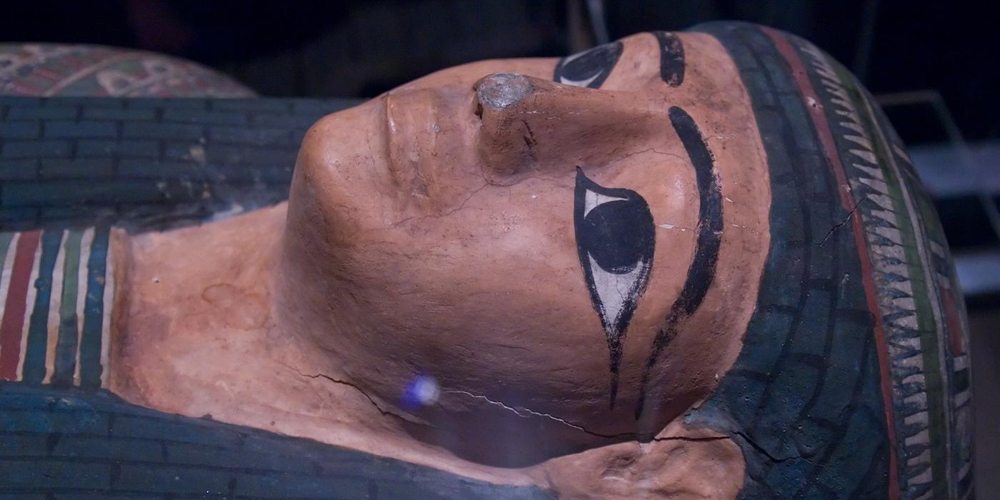
We were promised that it was the “must see exhibition of 2013.” As we drove into the city, we saw that the light poles in Baltimore were festooned with flags promising passing drivers that they didn’t want to miss this once-in-a-lifetime event. The Maryland Science Center was holding an exhibit called Mummies of the World. My nine-year-old daughter could not have been more excited to get her Egypt on.
Her brother opted out of seeing the exhibit, but my mother-in-law and I took my daughter up to the second floor opening which was being guarded by an employee who gave us the rules: no cell phones, no photographs, no re-admittance upon exit. There was no warning about what we would see once we were inside, no question asked by the science center employee whether my daughter was prepared. We entered knowing nothing about the exhibit, assuming that like all other exhibits we’ve attended at the science center, we would learn everything we needed to know at the exhibit. Since they are geared towards children, they usually don’t require research beforehand. Yet it would have been nice for this exhibit to come with a warning sign when purchasing tickets or outside the exhibit.
My daughter had seen mummies before at the British Museum and the Smithsonian. And yes, there were some mummies that were exactly as we imagined: cloth-bound; lying in stone coffins.
But we weren’t prepared for mummies like the Orlovits family from the late 1700s. The family of three were unintentionally preserved in their pine coffins, and were now on display in the exhibit. (Warning: feel free to skip the links with images.) Or this woman, who was propped up in the same room. This just wasn’t what we expected. Nor the Detmold child from Peru.
This video gives you a sense of the exhibit (though I only found this video upon returning home):
My daughter got through three darkened rooms, listening to the creepy quiet music playing in the background, before she paused near a priest’s sarcophagus and sank down on the floor, twisting her lip.
“I don’t know how I feel about this,” she told me. “All these people were in someone’s family. They were somebody’s mother. Or child. What if a museum put my family on display and everyone was walking through the room staring at you?”
The exhibit begins with an ethical statement, reminding visitors to be respectful of the dead. But it begs the question: can an exhibit of mummies ever be respectful of the dead? Is it respectful to put the dead in glass cases without their permission and allow visitors to gawk at them in the name of science? Are displays of mummies unethical? Or if there are no living descendants to offend, is it okay to put someone’s ancestor on display?
As we sat on the floor, I gave her the option to run through the rest of the exhibit and she took it. We booked it through the last few rooms, trying not to look too closely at the people in the cases, and only pausing if we passed an inanimate object. We popped out the other side, back in the hallway.
I’m not sure where I stand on mummy exhibits. I think the science itself can be done without creating exhibits. I think that while the exhibit should have come with a clear and visible warning, the vast majority of patrons would still proceed into the darkened rooms. Ancient civilizations are fascinating; the idea that you are looking at a person who was once walking around on this earth as you do now is gulp-worthy. Still, the difference between an exhibit such as Bodies and this one is the ability for the person or their family to give permission. Those people knew they were being preserved and going on display. These people had no clue they would one day end up in a museum.
There was a lot of care taken with the creation of this exhibit, from the educational materials to the special display cases holding the remains. But at the end of the day, does that care tell the whole story? Or as humans, do we need to be more circumspect on displaying humans without their permission?




Reminded me of a story I heard about Admiral Peary on the BBC show QI
“He [Peary] took some children; they took six of whom four died of TB instantly. And then one of them survived and was brought up by an American couple, and was then horrified to discover his parents, his father, as a skeleton in the Natural History Museum in New York, on display, and complained, and Peary refused to do anything about it, er, but reluctantly gave him enough money to carry home, and it wasn’t until 1993 that the remains of those Inuktituts were sent back to their homeland. ”
https://sites.google.com/site/qitranscripts/transcripts/7×04
Holy crap. Can you imagine seeing your father in a museum?
I guess I never acquired a squeamishness for remains, human or otherwise. I’m struggling with the idea that this might be seen as a lack of respect for the dead, but it’s quite the opposite.
I don’t believe in life after death, except insofar as the effects of your actions and ideas persist past passing, and whatever new life springs from the form you no longer animate. If a body raises daisies or feeds vultures, it’s no waste for the earth; if it raises questions and ideas, then it’s a benefit for us who’ve survived.
+1
I second that. ^
It is a beautiful idea. And as an adult, I could go through the exhibit thinking/feeling that. I’m not sure a nine-year-old kid — even one who doesn’t believe in life after death — would process seeing some of the mummified corpses in that way, even if they also rationally know that life ends with death. Or, at least my kid had trouble seeing a corpse propped up in case without wondering how that woman’s child would feel seeing his mother’s remains on display for people to pay to see.
LOL